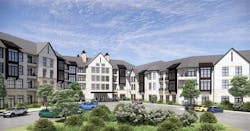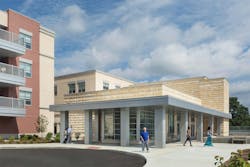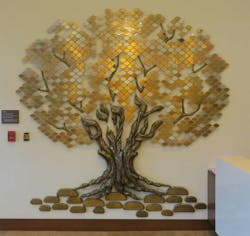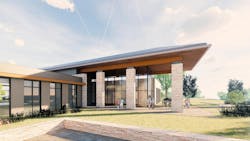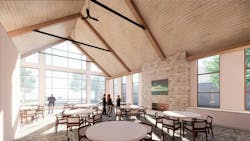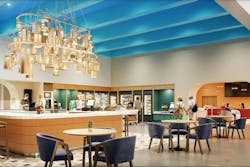The growing importance of cultural representation in senior living communities
Architects are often asked to design master plans and buildings that will enhance the culture and history of the places where they’re located. It requires sensitive engagement, especially as we commit more and more to diversity, equity, and inclusion—both on our design teams and for the people we serve.
In my graduate studies at Cornell University, I researched how architects could include culture in their work while also leaving room for folks to express themselves. My case study was the residential neighborhood of Harlem, N.Y., where generations of Black Americans have infused their culture into those homes, which were originally intended for affluent white folk. The experience has led me to further engage with this approach as an architect in Perkins Eastman’s Senior Living practice.
Expressing the culture of residents who are moving away from the homes where they’ve spent much of their lives has always been an important consideration, Senior Living Practice Area Leader Alejandro Giraldo says, but he’s recently observed a shift from mainly faith-based cultural considerations to broader notions of cultural affinity.
I’ve observed these forces at work in the South Asian influences of Priya Senior Living communities in Richmond, Texas, and Rochester Hills, Mich., and at a series of Veterans Homes in Minnesota. But faith-based representation remains a strong consideration; I’m personally engaged in a Stamford, Conn., project that speaks to the values of the company’s Jewish origins.
Serving Jewish Traditions and Beyond
Mozaic Concierge Living recently changed its name from Jewish Senior Services, whose communities have predominantly served a Jewish population. Inherent in our Stamford project is a desire to express a connection to Judaism both programmatically and architecturally while also welcoming residents from many denominations and faiths.
I spoke with Andrew Banoff, the president of Jewish Senior Services, about our history with Mozaic. In 2013 the company engaged Perkins Eastman to design a new Jewish Senior Services skilled nursing facility in Bridgeport, Conn., to replace an older building that was decommissioned. The new building needed to be particularly sensitive to the history of the organization, showcasing its support for Jewish people at a time when they weren’t welcomed at other senior living communities.
Banoff credits Perkins Eastman Principal Rich Rosen and interior designer Shannon Kobistek with their care in helping identify and highlight elements from the previous building that told the story of Mozaic’s past. Prime examples are the original building’s donor wall, which now hangs in the Bridgeport lobby and serves as a physical record of the community’s builders; a mosaic representation of the tree of life, or Etz Chaim; and 26 repurposed stained-glass windows in the backlight cases of the new public-entry corridor.
Perkins Eastman also used Jerusalem stone as a base material for the building and located it at strategic focal points, directly referencing the built environment of old Jerusalem in Israel.
Banoff says the company and its residents deemed the project a success by celebrating not just contemporary Judaism but also strengthening their ties to Jewish history while setting down roots for future generations.
Ten years later, the company’s latest project in Stamford visually echoes Bridgeport with Jerusalem stone that continues from the exterior to its prominent interior spaces that are designed for cultural celebrations. But the new property also aims to extend its mission beyond its Jewish faith.
“We don’t serve everyone because they’re Jewish. We serve everyone because we’re Jewish,” Banoff says. The new name—Mozaic—reflects not only that figurative goal, a tradition handed down by Moses, but is also a literal expression of the Etz Chaim mosaic in Bridgeport that continues to shine as a beacon for the company.
Honoring Veterans and Their Communities
Three new Veterans Administration homes in Minnesota, meanwhile, aim to reflect not only their residents’ proud military careers but also the unique characteristics of each community where they’re located.
Perkins Eastman led the design for these homes in Preston, Montevideo, and Bemidji in what’s been hailed as a paradigm shift, changing the status quo from an institutional model and recognizing residents as individuals with full, independent lives. The cultural thread here is their status as veterans and their shared stories, triumphs, and struggles from active duty.
In honor of that legacy, the design team designated space in each home to display plaques, medals, flags, and sculpture. The design and materials of each facility, furthermore, speak to the landscape. Despite VA design guidelines that dictate nearly identical layouts in each locale, their architectural expressions are all different:
Retiring in South Asian Style
Priya Senior Living, with locations in California, Michigan, and Texas (plus additional communities expected in the future), was built specifically to celebrate South Asian culture. Perkins Eastman is designing the communities in Rochester Hills, Mich., and Richmond, Texas, near Detroit and Houston respectively, with a focus on culture at various scales from program to finishes.
Programmatic elements include amenities like a chai bar and a flexible lounge to accommodate everything from parlor games and karaoke to Bollywood movie nights. Bright paint and finish colors suffuse each building, inspired by the palettes of saris and spice markets. The concept has taken off, founder Arun Paul says. He started with a single, repurposed apartment complex in California and has since expanded locally and nationally due to high demand from seniors wishing to be a part of a community that celebrates their heritage.
Paul and Mozaic’s Banoff both emphasized that celebrating one culture shouldn’t exclude others. It’s an invitation, rather, to enhance the identities and representations residents bring with them to each senior living community. Residents want to live in a place that allows them to “feel good because they feel included and part of the community,” says Giraldo, Perkins Eastman’s senior living practice leader. Designing with culture in mind, he adds, further helps them strengthen their connections to place, friendship, memories, and faith as they move into the next chapter of their lives.
About the Author
Perkins Eastman
Perkins Eastman is a network of more than 1,100 thinkers, dreamers, and doers dedicated to the human experience. While our practice spans sixty countries across five continents, each project is distinctly local—a dynamic structure, space, or solution for people to live, learn, work, play, and heal. Our blog, Insights, is proud to cover the design and innovation that is constantly emerging from our eighteen practice areas and twenty-four interdisciplinary studios worldwide. Find us on LinkedIn, Instagram, Twitter, and Vimeo.

